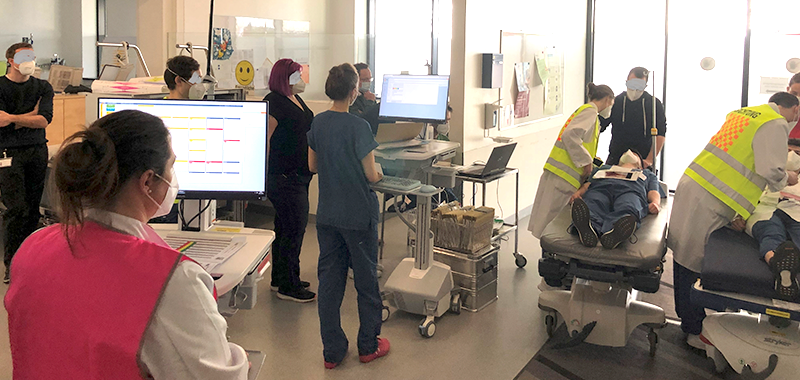
The LMU Hospital Munich recognises the importance of planning and preparing for large-scale emergencies and continues to carry regular mass casualty incident exercises even throughout the ongoing Covid-19 pandemic. The goal is to put current concepts into practice to ensure that hospital staff is well prepared in case of emergency.
The organizational and financial burden of mass casualty exercises in a hospital is rather high (1). Contrary to other German federal states, Bavaria does not provide funding for any mass casualty incident exercises. The Institut of Emergency Medicine and Medicine Management at LMU Hospital Munich has developed an exercise plan, which is efficient from varied perspectives – cost, time, and staffing. This plan is covering all important steps and procedures which are needed to be put into practice by the hospital staff in case of a large scale emergency, for instance a mass casualty incident.
Based on experience, it is especially important that a proper protocol is in place so that staff can act quickly and confidently during the initial phase, i.e. the time between the A&E department first being notified of the occurrence of the mass casualty incident and the first patients arriving at hospital. Overall, the protocol should be adapted as early as possible to the particular challenges of a mass casualty incident (2).
A mass casualty exercise will start with the A&E department being notified that an exercise is about to be carried out. They will be briefed about the scenario (e.g. a train crash) while observers will monitor the staff’s reaction and response and how they put the protocols and checklists into practice. The certified first responders shall be informed, the level of emergency has to be established, off-duty staff might need to be called in, the building might need to be secured (or at least it should be considered), extra or spare equipment might need to be pulled out of storage, non-acute patients might need to be cleared out of the A&E and triage will need to be prepared and conducted. Simultaneously, all other responders shall be informed and a system of communication will be established. Additionally, intensive care units and operating theatres will as well need to be informed of the mass casualty incident. In an ideal scenario, all the aforementioned steps will be completed before the first patient arrives at the A&E department.
Another focus of the exercise is triage and documentation. The exercise protocol has a specific section for this purpose, employing mock victims depicting a predefined injury pattern and story. Hospital staff will perform triage on them based on a pre-established algorithm to differentiate high and lower priority patient groups. To conclude the exercise, the detail and quality of documentation and traceability will be evaluated.
- Schweigkofler U, Kleber C, Auhuber T.C, H.G Jung, Cwojdzinski D (2019) Kostenabschätzung für MANV-Übungen im Krankenhaus. Der Unfallchirurg 122: 381-386
- Schweigkofler U, Heinz S, Hoffmann R (2018) Massenanfall von Verletzten im Krankenhaus. Trauma Berufskrankh 20:171–176
Written by LMU Team – Philipp Fischer, Dr. Marc Lazarovici, Dr. Katarina Grujic



